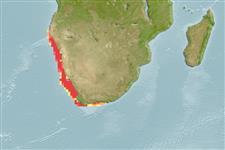Common names from other countries
Environment: milieu / climate zone / depth range / distribution range
Ökologie
seewasser bathydemersal; tiefenbereich 100 - 400 m (Ref. 5304). Deep-water; 17°S - 35°S, 10°E - 25°E
Southeast Atlantic: northern Namibia to False Bay, South Africa.
Size / Gewicht / Alter
Maturity: Lm ? range ? - ? cm
Max length : 75.0 cm TL Männchen/unbestimmt; (Ref. 3200); max. veröff. Gewicht: 4.0 kg (Ref. 3200)
Kurzbeschreibung
Bestimmungsschlüssel | Morphologie | Morphometrie
Rückenflossenstacheln (insgesamt) : 0; Rückenflossenweichstrahlen (insgesamt) : 82 - 100; Afterflossenstacheln: 0; Afterflossenweichstrahlen: 65 - 78; Wirbelzahl: 55 - 57. Dorsal and anal fins continuous with caudal fin (Ref. 36731). Right pectoral fin more than half of, but shorter than head length; left pectoral fin present (Ref. 36731). Brownish with small dark specks; sometimes with bars on body (Ref. 3200).
Larvae are pelagic (Ref. 27121, Ref. 36731), while adults live close to the sea bed (Ref. 36731). Adults feed on worms, crustaceans, mollusks, and fish (Ref. 27121, Ref. 36731). Utilized as a food fish (Ref. 4931).
Life cycle and mating behavior
Maturities | Fortpflanzung | Spawnings | Egg(s) | Fecundities | Larven
Heemstra, P.C. and O. Gon, 1986. Soleidae. p. 868-874. In M.M. Smith and P.C. Heemstra (eds.) Smiths' sea fishes. Springer-Verlag, Berlin. (Ref. 3200)
IUCN Rote Liste Status (Ref. 130435)
CITES (Ref. 128078)
Not Evaluated
Bedrohung für Menschen
Harmless
Nutzung durch Menschen
Fischereien: weniger kommerziell
Tools
Zusatzinformationen
Download XML
Internet Quellen
Estimates based on models
Preferred temperature (Ref.
115969): 9.2 - 11.9, mean 10.4 (based on 37 cells).
Phylogenetic diversity index (Ref.
82804): PD
50 = 0.7500 [Uniqueness, from 0.5 = low to 2.0 = high].
Bayesian length-weight: a=0.00977 (0.00473 - 0.02021), b=3.07 (2.90 - 3.24), in cm Total Length, based on LWR estimates for this (Sub)family-body shape (Ref.
93245).
Trophic level (Ref.
69278): 3.5 ±0.45 se; based on food items.
Widerstandsfähigkeit (Ref.
120179): niedrig, Verdopplung der Population dauert 4,5 - 14 Jahre. (K=0.07).
Fishing Vulnerability (Ref.
59153): Moderate to high vulnerability (50 of 100).
Climate Vulnerability (Ref.
125649): Very high vulnerability (89 of 100).
